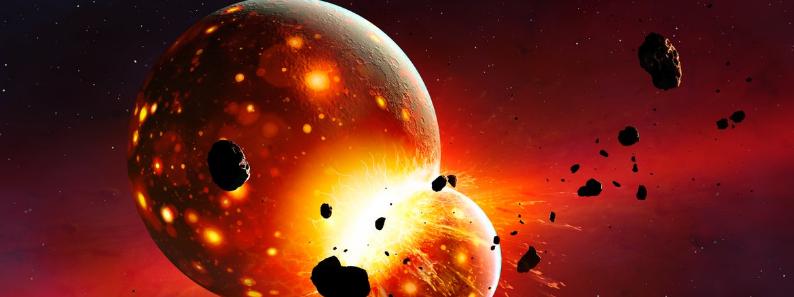Introduction: Theia impact, one of the three mainstream conjectures about the formation of the moon, recently proposed a new verification model, that is, according to the computer simulation of the Earth-Theia impact event, although most of the debris of Theia should have been thrown into space, there are still some fragments that should be fused with the Earth and buried deep inside the Earth, and researchers speculate that this part of the fragments are located in the subsurface of Africa and the Pacific Ocean.

An ancient protoplanet may be buried beneath the Pacific Ocean — and finally scientists may be able to find evidence of the moon's formation.
New theories suggest that in ancient times, the consequences of a collision between Earth and a smaller protoplanet could have been hidden deep in Earth's mantle.
The hypothesis comes from a team of scientists at Arizona State University who agree that the remains of an ancient protoplanet known as Theia are likely buried in deep rocks beneath West Africa and the Pacific Ocean.
Scientists presented this hypothesis at the 52nd Lunar and Planetary Science Conference. The theory will be elaborated in a paper published in the journal Geophysical Research Communications.
Importance: If this hypothesis proves correct, then it provides the first direct evidence for the formation of the lunar impact hypothesis.
Qian Yuan, a phD student at Arizona State University's School of Earth and Space Exploration and lead author of the new paper, proposed the hypothesis in a class on planetary geochemistry about the story of the origin of the Earth and Moon.
Scientists believe that sometime about 4 billion years ago, a huge Object the size of Mars known as Theia collided with a young, developing Earth. Theoretically, the collision threw vaporized particles from Earth into space, which were combined by gravity to form the moon.
Illustration: The early solar system was a very chaotic existence
This impact hypothesis remains to be examined. But it's one of three main theories about how the moon formed. The other two theories suggest that the Moon either formed simultaneously with Earth in place or as a free body trapped by Earth's gravitational field.
"Although the huge impact hypothesis about the formation of the Moon is widely accepted, scientists have found it difficult to provide direct evidence for the existence of the hypothetical impactor Theia," Yuan told Inverse.
"It inspired me that I thought the missing Theia might have entered Earth after the impact."
Update: Yuan and his colleagues were curious about two large chunks in Earth's mantle, located below West Africa and the Pacific Ocean. The earth's core is sandwiched between these chunks.
These masses, officially known as large low-shear velocity zones, are detected by seismic waves —these are energy waves that travel through the Earth's layer during earthquakes. As seismic waves pass through these expanders, they slow down. Scientists have observed that these expanders are much hotter and denser than the surrounding material.
Scientists aren't sure why these regions formed in this way. But previous evidence suggests they've been around since the moon formed billions of years ago.
According to the new hypothesis, these plaques may actually be remnants of Theia.
How they did it: Behind this new study, scientists created a young model of Earth, like Earth 4.5 billion years ago, and then simulated Earth's collision with a Mars-sized object (Theia).
According to their model, most of Theia would be thrown into space when it collided with Earth. But fragments of Theia, like fragments of bomb explosions, may have entered the mantle of the earth. Over billions of years, these fragments may have melted into earth and formed two different orbs.
Next : The only way to prove this hypothesis is to take samples from large low-shear velocity regions that are deep in the Earth's surface. The scientists will then need to compare these samples with rock samples they collected from the moon. Some of these lunar samples are more than 50 years old and were brought back during NASA's Apollo mission.
"If our hypothesis is correct, there should be some chemical connection between the Moon and LLSVPs," Yuan said.
"If such a link is established, the LLSVPs are most likely remnants of the impactor Theia."
Ultimately, collecting these samples meant drilling deep into the surface below the Pacific Ocean, a daunting task made more difficult due to water bodies. Or underground in West Africa. But if scientists can build a robot capable of drilling for life on Mars, that effort may not be as difficult as we think.
BY: inverse
FY: Autumn white
If there is any infringement of the relevant content, please contact the author to delete it after the work is published
Please also obtain authorization to reprint, and pay attention to maintaining completeness and indicating source